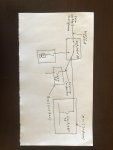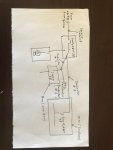timm333
Senior Member
- Location
- Minneapolis, MN
- Occupation
- Electrical Design Engineer
I have a question about tap conductor as per NEC 240.21(B)(5). The service conductor cannot be tapped; however automatic transfer switch (ATS) has service conductor (service lateral) only on the incoming side.
Can the outgoing copper feeder of a service-entrance rated automatic transfer switch (ATS) be tapped as shown in the attached sketch? Thanks
Can the outgoing copper feeder of a service-entrance rated automatic transfer switch (ATS) be tapped as shown in the attached sketch? Thanks


